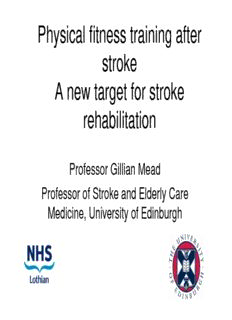
Physical fitness training after stroke A new target for stroke rehabilitation PDF
Preview Physical fitness training after stroke A new target for stroke rehabilitation
Physical fitness training after stroke A new target for stroke rehabilitation Professor Gillian Mead Professor of Stroke and Elderly Care Medicine, University of Edinburgh Declarations of interest • Funding (Stroke Association, CHSS, Chief Scientist Office, Greater Glasgow and Clyde, Edinburgh Leisure, Scottish Government) • Royalties-from Later Life Training (www.laterlifetraining.co.uk) that provide an Exercise after stroke course for exercise professionals • Honoraria for lectures on this topic Exercise and stroke? Exercise and stroke Does immobility after stroke reduce both aerobic fitness and muscle strength? If we improve physical fitness, might stroke- related disability be reduced? Mead BMJ 2005 The Old Royal Infirmary, Edinburgh, established 1729 At Lauriston Place, from 1879 The New Royal Infirmary (2006-); >900 in-patient beds Questions • What happens to physical activity after stroke? • What happens to physical fitness after stroke? • What are the associations between physical fitness and function and fatigue? • What are the benefits (and risks) of exercise after stroke? – Physical function – Other benefits (and risks) • How can we translate evidence into practice – Training the trainers – Setting up exercise services – Some of the barriers! • How can we support stroke survivors to become more active? Physical activity • All bodily movement produced by the contraction of skeletal muscle and which substantially increases energy expenditure (USDHHS 1996) • Includes the muscular work required for – Walking – Maintaining posture – Activities of daily living – Occupational, leisure and sporting activities
Description: